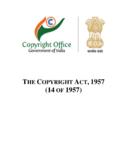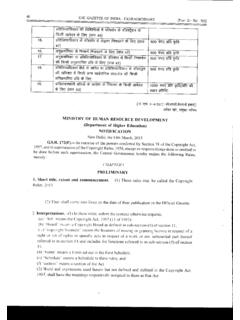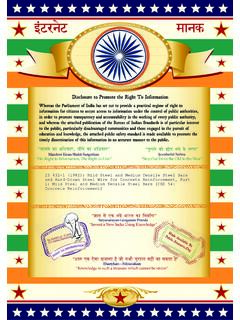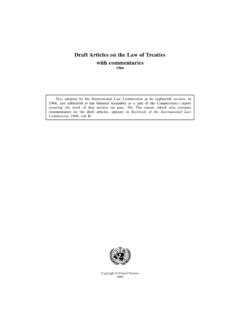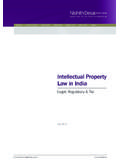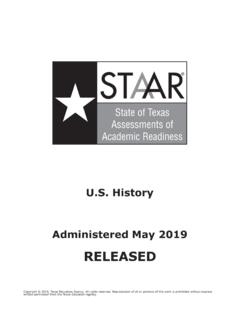Transcription of THE COPYRIGHT ACT 1957 (14 OF 1957)
1 THE COPYRIGHT ACT, 1957 (14 OF 1957) COPYRIGHT Office Department Of Industrial Policy & Promotion Ministry of Commerce and Industry THE COPYRIGHT ACT, 1957 ACT NO. 14 OF 1957 [4th June, 1957] An Act to amend and consolidate the law relating to COPYRIGHT . BE it enacted by Parliament in the Eighth Year of the Republic of India as follows:- CHAPTER I PRELIMINARY 1. Short title, extent and commencement. (1) This Act may be called the COPYRIGHT Act, 1957. (2) It extends to the whole of India. (3) It shall come into force on such date as the Central Government may, by notification in the Official Gazette, appoint. 2. Interpretation. In this Act, unless the context otherwise requires, (a) adaptation means,- (i) in relation to a dramatic work, the conversion of the work into a non-dramatic work; (ii) in relation to a literary work or an artistic work, the conversion of the work into a dramatic work by way of performance in public or otherwise; (iii) in relation to a literary or dramatic work, any abridgement of the work or any version of the work in which the story or action is conveyed wholly or mainly by means of pictures in a form suitable for reproduction in a book, or in a newspaper, magazine or similar periodical; (iv) in relation to a musical work, any arrangement or transcription of the work; and (v) in relation to any work, any use of such work involving its rearrangement or alteration; (aa) Appellate Board means the Appellate Board referred to in section 11.
2 (b) work of architecture means any building or structure having an artistic character or design, or any model for such building or structure; (c) artistic work means, (i) a painting, a sculpture, a drawing (including a diagram, map, chart or plan), an engraving or a photograph, whether or not any such work possesses artistic quality; (ii) a work of architecture; and (iii) any other work of artistic craftsmanship; (d) author means, (i) in relation to a literary or dramatic work, the author of the work; (ii) in relation to a musical work, the composer; (iii) in relation to an artistic work other than a photograph, the artist; (iv) in relation to a photograph, the person taking the photograph; (v) in relation to a cinematograph film or sound recording, the producer; and (vi) in relation to any literary, dramatic, musical or artistic work which is computer-generated, the person who causes the work to be created; (dd) broadcast means communication to the public (i) by any means of wireless diffusion, whether in any one or more of the forms of signs, sounds or visual images; or (ii) by wire, and includes a re-broadcast; (e) calendar year means the year commencing on the 1st day of January; (f) cinematograph film means any work of visual recording and includes a sound recording accompanying such visual recording and cinematograph shall be construed as including any work produced by any process analogous to cinematography including video films; (fa) commercial rental does not include the rental, lease or lending of a lawfully acquired copy of a computer programme, sound recording, visual recording or cinematograph film for non-profit purposes by a non-profit library or non-profit educational institution; Explanation.
3 For the purposes of this clause, a non-profit library or non-profit educational institution means a library or educational institution which receives grants from the Government or exempted from payment of tax under the Income-tax Act, 1961(43 of 1961). (ff) communication to the public means making any work or performance available for being seen or heard or otherwise enjoyed by the public directly or by any means of display or diffusion other than by issuing physical copies of it, whether simultaneously or at places and times chosen individually, regardless of whether any member of the public actually sees, hears or otherwise enjoys the work or performance so made available. Explanation. For the purposes of this clause, communication through satellite or cable or any other means of simultaneous communication to more than one household or place of residence including residential rooms of any hotel or hostel shall be deemed to be communication to the public; (ffa) composer , in relation to a musical work, means the person who composes the music regardless of whether he records it in any form of graphical notation; (ffb) computer includes any electronic or similar device having information processing capabilities; (ffc) computer programme means a set of instructions expressed in words, codes, schemes or in any other form, including a machine readable medium, capable of causing a computer to perform a particular task or achieve a particular result; (ffd) COPYRIGHT society means a society registered under sub-section (3) of section 33.
4 (g) delivery , in relation to a lecture, includes delivery by means of any mechanical instrument or by broadcast; (h) dramatic work includes any piece for recitation, choreographic work or entertainment in dumb show, the scenic arrangement or acting, form of which is fixed in writing or otherwise but does not include a cinematograph film; (hh) duplicating equipment means any mechanical contrivance or device used or intended to be used for making copies of any work; (i) engravings include etchings, lithographs, wood-cuts, prints and other similar works, not being photographs; (j) exclusive licence means a licence which confers on the licensee or on the licensee and persons authorised by him, to the exclusion of all other persons (including the owner of the COPYRIGHT ) any right comprised in the COPYRIGHT in a work, and exclusive licensee shall be construed accordingly; (k) Government work means a work which is made or published by or under the direction or control of (i) the Government or any department of the Government; (ii) any Legislature in India; (iii) any court, tribunal or other judicial authority in India; (l) Indian work means a literary, dramatic or musical work, (i) the author of which is a citizen of India; or (ii) which is first published in India; or (iii) the author of which, in the case of an unpublished work, is, at the time of the making of the work, a citizen of India; (m) infringing copy means (i) in relation to a literary, dramatic, musical or artistic work, a reproduction thereof otherwise than in the form of a cinematographic film; (ii) in relation to a cinematographic film, a copy of the film made on any medium by any means; (iii) in relation to a sound recording, any other recording embodying the same sound recording, made by any means.
5 (iv) in relation to a programme or performance in which such a broadcast reproduction right or a performer s right subsists under the provisions of this Act, the sound recording or a cinematographic film of such programme or performance, if such reproduction, copy or sound recording is made or imported in contravention of the provisions of this Act; (n) lecture includes address, speech and sermon; (o) literary work includes computer programmes, tables and compilations including computer databases; (p) musical work means a work consisting of music and includes any graphical notation of such work but does not include any words or any action intended to be sung, spoken or performed with the music; (q) performance , in relation to performer s right, means any visual or acoustic presentation made live by one or more performers; (qq) performer includes an actor, singer, musician, dancer, acrobat, juggler, conjurer, snake charmer, a person delivering a lecture or any other person who makes a performance; Provided that in a cinematograph film a person whose performance is casual or incidental in nature and, in the normal course of the practice of the industry, is not acknowledged anywhere including in the credits of the film shall not be treated as a performer except for the purpose of clause (b) of Section 38B; (s) photograph includes photo-lithograph and any work produced by any process analogous to photography but does not include any part of a cinematograph film.
6 (t) plate includes any stereotype or other plate, stone, block, mould, matrix, transfer, negative, duplicating equipment or other device used or intended to be used for printing or reproducing copies of any work, and any matrix or other appliance by which sound recording for the acoustic presentation of the work are or are intended to be made; (u) prescribed means prescribed by rules made under this Act; (uu) producer , in relation to a cinematograph film or sound recording, means a person who takes the initiative and responsibility for making the work; (x) reprography means the making of copies of a work, by photocopying or similar means; (xa) Right Management Information means, (a) the title or other information identifying the work or performance; (b) the name of the author or performer; (c) the name and address of the owner of rights; (d) terms and conditions regarding the use of the rights; and (e) any number or code that represents the information referred to in sub-clauses (a) to (d), but does not include any device or procedure intended to identify the user.
7 (xx) sound recording means a recording of sounds from which such sounds may be produced regardless of the medium on which such recording is made or the method by which the sounds are produced; (xxa) visual recording means the recording in any medium, by any method including the storing of it by any electronic means, of moving images or of the representations thereof, from which they can be perceived, reproduced or communicated by any method. (y) work means any of the following works, namely: (i) a literary, dramatic, musical or artistic work; (ii) a cinematograph film; (iii) a sound recording; (z) work of joint authorship means a work produced by the collaboration of two or more authors in which the contribution of one author is not distinct from the contribution of the other author or authors; (za) work of sculpture includes casts and models. 3. Meaning of publication. For the purposes of this Act, publication means making a work available to the public by issue of copies or by communicating the work to the public.
8 4. When work not deemed to be published or performed in public. Except in relation to infringement of COPYRIGHT , a work shall not be deemed to be published or performed in public, if published, or performed in public, without the licence of the owner of the COPYRIGHT . 5. When work deemed to be first published in India. For the purposes of this Act, a work published in India shall be deemed to be first published in India, notwithstanding that it has been published simultaneously in some other country, unless such other country provides a shorter term of COPYRIGHT for such work; and a work shall be deemed to be published simultaneously in India and in another country if the time between the publication in India and the publication in such other country does not exceed thirty days or such other period as the Central Government may, in relation to any specified country, determine. 6. Certain disputes to be decided by Appellate Board.
9 If any question arises (a) whether a work has been published or as to the date on which a work was published for the purposes of Chapter V, or (b) whether the term of COPYRIGHT for any work is shorter in any other country than that provided in respect of that work under this Act, it shall be referred to the Appellate Board constituted under section 11 whose decision thereon shall be final: Provided that if in the opinion of the Appellate Board, the issue of copies or communication to the public referred to in section 3 was of an insignificant nature, it shall not be deemed to be publication for the purposes of that section. 7. Nationality of author where the making of unpublished work is extended over considerable period. Where, in the case of an unpublished work, the making of the work is extended over a considerable period, the author of the work shall, for the purposes of this Act, be deemed to be a citizen of, or domiciled in, that country of which he was a citizen or wherein he was domiciled during any substantial part of that period.
10 8. Domicile of corporations. For the purposes of this Act, a body corporate shall be deemed to be domiciled in India if it is incorporated under any law in force in India. CHAPTER II COPYRIGHT OFFICE AND APPELLATE BOARD 9. COPYRIGHT Office. (1) There shall be established for the purposes of this Act an office to be called the COPYRIGHT Office. (2) The COPYRIGHT Office shall be under the immediate control of the Registrar of Copyrights who shall act under the superintendence and direction of the Central Government. (3) There shall be a seal for the COPYRIGHT Office. 10. Registrar and Deputy Registrar of Copyrights. (1) The Central Government shall appoint a Registrar of Copyrights and may appoint one or more Deputy Registrars of Copyrights. (2) A Deputy Registrar of Copyrights shall discharge under the superintendence and direction of the Registrar of Copyrights such functions of the Registrar under this Act as the Registrar may, from time to time, assign to him; and any reference in this Act to the Registrar of Copyrights shall include a reference to a Deputy Registrar of Copyrights when so discharging any such functions.
